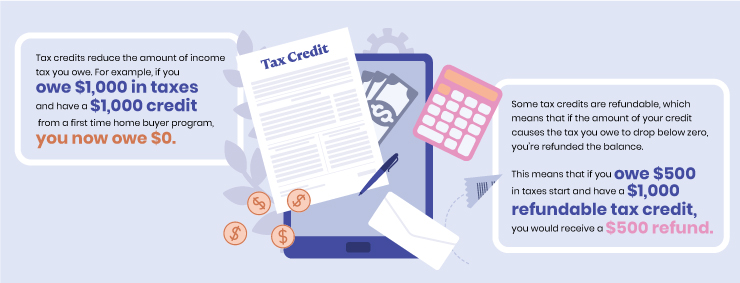What is the First-Time Home Buyer Tax Credit and How to Get It

If you’re a first-time home buyer you may have heard the term “tax credit” thrown around. And if you’re one of the many home buyers who are unsure what it means or how it can help, trust us, you’re not alone.
In essence, tax credits make it possible to reduce the amount of income tax you pay, as those credits are directly applied to your balance owing. First-time home buyer tax credits are designed to encourage new owners to make the leap from renting to property purchase by reducing their total tax burden.
In 2008, the federal government passed the Housing and Economic Recovery Act, which was designed in part to encourage new home ownership after the 2007-2008 economic crisis. In 2010, however, the program ended.
Many states stepped in to fill the gaps with tax credit and deduction benefits of their own, and there are also grant and tax-free options available from other sources. Not sure where to start? Here’s what you need to know about first-time home buyer tax credit programs and how they can help you get into your first home, faster.
How Do Tax Credits Work?
Tax credits reduce the amount of income tax you owe. For example, if you owe $1,000 in taxes and have a $1,000 credit from a first time home buyer program, you now owe $0. Some tax credits are refundable, which means that if the amount of your credit causes the tax you owe to drop below zero, you’re refunded the balance. This means that if you owe $500 in taxes start and have a $1,000 refundable tax credit, you would receive a $500 refund.

As noted above, tax deductions are different than tax credits. While many states offer a first-time home buyer deduction on property taxes or mortgage interest in your first year of home ownership, these deductibles only reduce your total taxable income. In practice, this means that if your taxable income is $50,000 and you have a $10,000 deduction, your tax owing will be calculated as if your income was only $40,000. In general, credits outpace deductions for total tax reduction, but both offer benefits for first time home buyers.
How Do You Get the Tax Credit?

Accessing the first-time home buyer tax refund, deduction or credit program varies from state to state. Generally speaking, you’ll need to apply with the state agency or government-approved financial firm that administers this program in your state by providing documentation that details your recent home purchase, demonstrates that you’re a first-time home buyer and provides personal information including Social Security Numbers (SSNs), credit reports and current financial status.
In some states — such as Alabama and Illinois — down payment assistance programs come with specific credit score requirements. Other options, such as the Mortgage Credit Certificate (MCC) for homeowners with a CHFA mortgage, require homeowners to meet income limits set out by both CHFA and HUD.
First-Time Home Buyer Tax Credit Options

While the federal first-time home buyer tax credit is no longer available, many states now offer their own programs, including:
- Ohio — In Ohio, first-time home buyers can leverage the Ohio Housing Finance Agency’s Mortgage Tax Credit, which provides a direct, nonrefundable federal tax credit for a portion of their mortgage interest. In order to use this credit, home buyers must have federal tax owing and the total amount of the credit cannot be larger than their current tax liability.
- California — In California, buyers can apply for the state’s mortgage credit certificate (MCC), which is offered by the California Housing Finance Agency (CalFHA). The MCC allows first-time buyers to covert a portion of their mortgage interest into a dollar-for-dollar tax credit, but comes with specific income limits of $71,400 for one- or two-member families and $81,110 for families of three or more.
- Maryland — First-time home buyers in Maryland can access the Maryland HomeCredit program, which allows homeowners to claim a federal tax credit up to 25% of their mortgage interest payments to a maximum of $2,000 per year.
- Delaware — Buyers purchasing their first home in Delaware can apply for a $2,000 tax credit on their federal income tax. This benefit is available for every year the owner occupies their home and carries a mortgage.
Alternative First-Time Assistance
If your state doesn’t offer a first time home buyer credit, there are other benefits available.
First, check out the federal government’s Housing and Urban Development (HUD) website, which provides information on accessing grants and mortgage assistance programs. Next, consider leveraging a part of your traditional or Roth IRA: Every first-time home buyer is eligible to access up to $10,000 from their IRA without paying the 10% early withdrawal penalty, although it’s worth noting that if you have a traditional IRA you’ll still be required to pay income tax on any money withdrawn.
Some states offer non-credit programs, such as:
- Illinois — Instead of a direct tax credit, Illinois offers forgivable purchase assistance. New home buyers can access up to $6,000 in assistance for down payments and closing costs, with a portion of the money owing forgiven each month over 10 years. While both new and existing homes are covered by the program, income limits apply and the state requires a minimum credit score of 640.
- Alabama — The Alabama Housing Finance Authority (AHFA) offers a first-time home buyer program that provides 3% down payment assistance and a mortgage insurance discount for buyers with a conventional loan. Worth noting? The AHFA requires a minimum credit score of 620 and homeowners must move into their new home within 60 days after closing.
Other options to help reduce the financial strain of first-time home ownership include:
- Federal Loans — These include Federal Housing Administration (FHA) loans or Department of Veterans Affairs (VA) loans, which are designed to help buyers with lower credit scores and those with military service, respectively. First-time home buyers who are also indigenous Americans, meanwhile, may qualify for a Section 184 Loan, which requires only a 2.25% down payment on loans over $50,000.
- Residential Energy Credits — If you choose to install renewable energy technologies — such as solar panels, geothermal systems or wind turbines — into your new home, you may be able to claim a tax credit of up to 30% of the total cost.
- Freddie Mac/Fannie Mae Mortgages — Freddie Mac and Fannie Mae mortgages were created by the federal government to help low-income buyers with minimal credit purchase their first homes. Both the HomeReady Loan from Fannie Mae and the Home Possible offerings from Freddie Mac require only a 3% down payment, and the Freddie Mac variant is available as a 15 or 30-year fixed, 5/5, 5/1, 7/1 and 10/1 adjustable ARMs. And if you’re interested in buying a fixer-upper, the Fannie Mae HomePath ReadyBuyer program lets you access 3% worth of closing cost assistance after completing an online home buying education course.
Some states also offer property tax deductions based on the value of your home — the greater the value and the more taxes you pay, the more you can claim. It’s worth noting, however, that the Tax Cuts and Jobs Act (TCJA) has capped this deduction at $10,000, and unlike a tax credit, a deduction doesn’t directly reduce the total amount you owe on your taxes each year. Instead, it simply lowers the total amount of your income that can be taxed each year.
Finding Your First-Time Buyer Best Fit
While the federal first-time home buyer tax credit offered under HERA is no longer available, other options exist to help reduce the financial stress of buying your first home. Your best fit depends on your current needs and location — in some states, government assistance programs offer tax credits or deductions, while federal options such as Freddie Mac, Fannie Mae or VA Loans — along with energy credits and IRA withdrawals — can help offset the initial costs of new home ownership.






